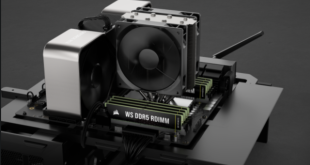In the wake of Toshiba's announcement, KitGuru has been speaking with industry insiders about the memory market. While the biggest impact for Toshiba will be in the tablet/handheld markets, we also consider what future improvements to DDR3 processes could do to the desktop PC.
It might come as a surprise, but Toshiba does do other things when it is not actively engaged in the production of nuclear power plants, like the one causing all the grief at Fukushima. One of those things is memory. The company has just announced successful manufacture of 19nm products – the smallest ever. Similar moves must be close from other vendors, which got us thinking.
The few benchmarks available online which focus on the movement from 4GB to 8GB and 16GB in a desktop system, running standard applications – tend to struggle to find benefits. The only one we can remember seeing was a ~10% boost, moving from 8GB to 16GB, in the Music Score section of PC Mark Vantage. Hardly a huge driver to make people want to upgrade.
That said, with an improved version of Windows on the 12-18 month horizon and companies like Adobe tweaking under the hood of products like CS6, there has to be a better world around the corner.
KitGuru recently spent time talking [Off the record, sorry – Ed] with two of the biggest desktop memory companies around and we managed to bring up the subject of DDR3 sizes with both. Surprisingly, they held completely opposite viewpoints. We're keen to raise this point for discussion – to see how the KitGuru audience views the world.
The movement from 16MB to 512MB and then 4GB seemed to happen in a flash (no pun intended). Each time, we all thought we had plenty of memory, but then process changes/software updates came along and we all found ourselves reaching for more.
We have been on 4GB now for many, many years. Indeed, if you put tablets and netbooks into the mix – then things have actually been going ‘backwards' in a lot of cases.
So what are the really important factors that determine how much RAM we get to use?
Typically, local system builders will spend up to £40 on PC memory without really thinking about it. Based on 4GB in a box, you don't need to be Newton to see that there is a budget of £10 per GB. To deliver a competitively priced 16GB PC to market, your supplier would need to be able to buy 1GB for £2.50.
Remember, these are cost prices for the system builder – not the price you see on the shelves at Scan, YOYOTech and Dabs.
So what would a move to 16GB mean?
First, this is not a mass-market number. You are not going to see it plastered across the shelves in John Lewis and PC World – but Xmas 2012 could see a lot of KitGuru readers making the move if one of two things happen:-
- Applications improve on their ability to utilise larger amounts of memory
- The required price points are hit
The first has 2 possible solutions. Either Microsoft enables some serious improvements in Windows 8 or the developers themselves code for a larger amount of RAM. Both have to be possibilities.
Microsoft having multiple versions of its operating system has proven confusing and allowed Google to get a foothold. If Windows 8 is late enough, then we won't just see Android V3 – but possibly also V4 by the time that Windows 8 lands. Microsoft creating an operating system that scales really well with additional resources could prove beneficial.
Developers themselves are looking at a future where more and more systems – of all shapes and sizes – are booting from and running on SSD. Those SSD drives will get bigger and faster over time, so it makes good sense to have an open approach to memory size – with great scaling. The lines between storage types are melting away.
Whatever happens next, this will be a nice break for Toshiba. Its PR team can speak about positives instead of having to defend their designs in the Fukushima nuclear plant.

KitGuru says: Toshiba won't be the only company that makes manufacturing breakthroughs in memory size (both smaller process and larger amounts) over the next 12-18 months. While the mass-market will continue to focus on ‘how much more performance can you get from existing memory sizes', there is a definite market for large memory systems if [And that's a big IF – Ed] applications can show a real benchmark delta when each additional GB is applied.
Comments below or in the KitGuru forum.
 KitGuru KitGuru.net – Tech News | Hardware News | Hardware Reviews | IOS | Mobile | Gaming | Graphics Cards
KitGuru KitGuru.net – Tech News | Hardware News | Hardware Reviews | IOS | Mobile | Gaming | Graphics Cards


